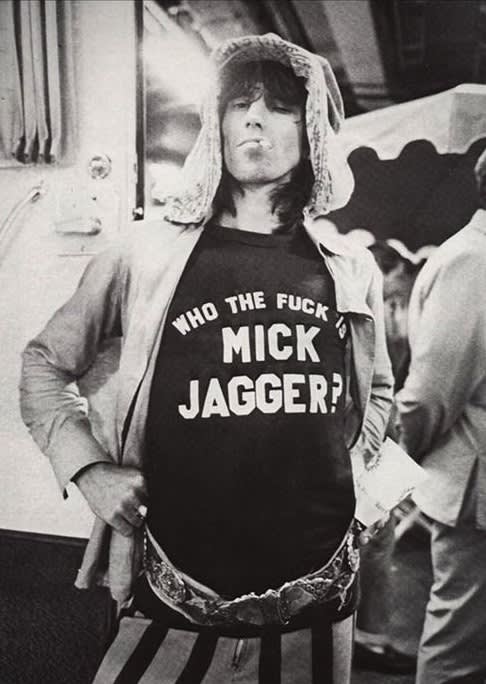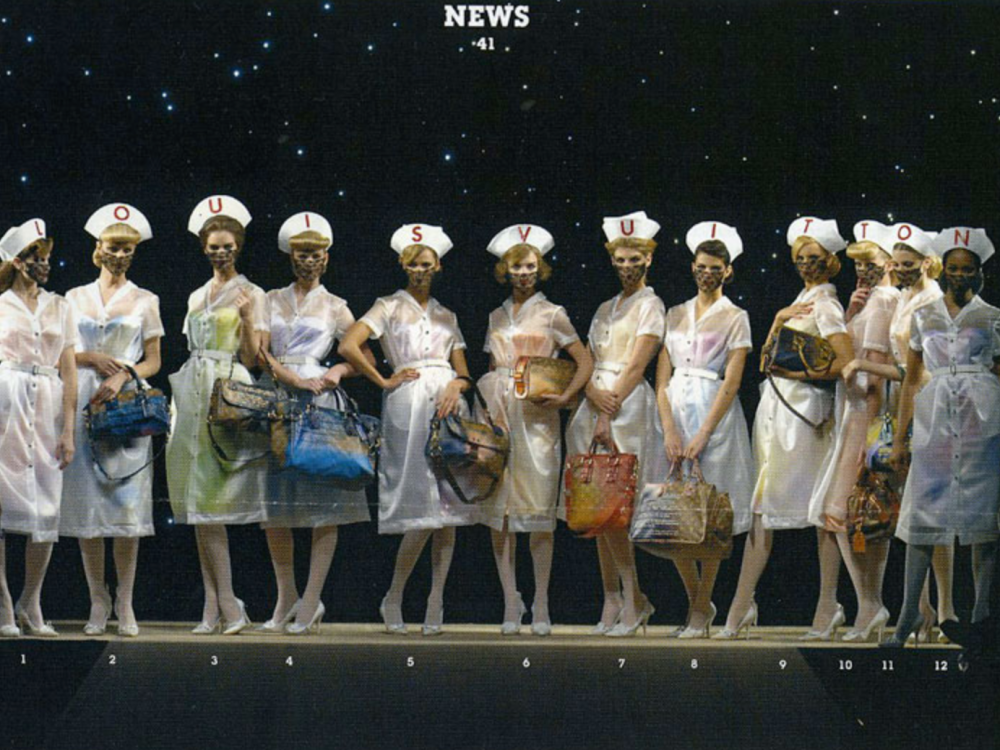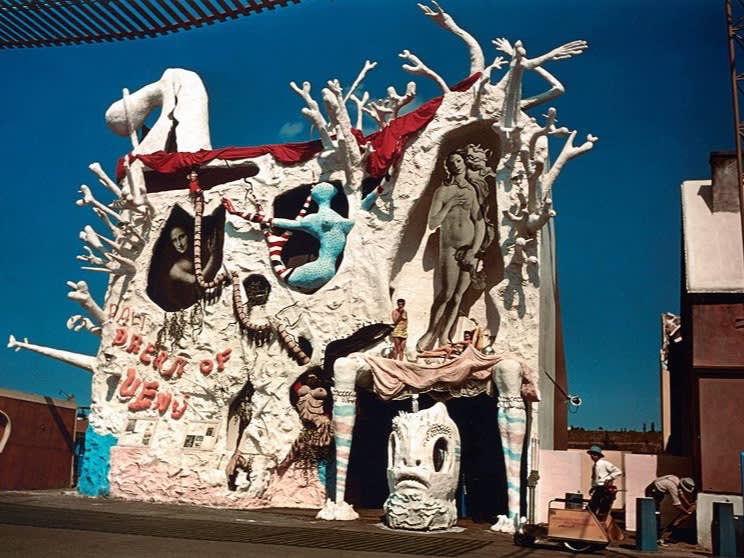
Keith Richards wearing a "Who the F*ck is Mick Jagger?" T-Shirt
During the Rolling Stones' Tour of the Americas, 1975
Merch has a deep-rooted history in the constructs of popular culture and branding. From early concert t-shirts and a favorite sports team’s jersey or baseball cap, to vintage postcards, an EPCOT mug, and all other forms of treasured ephemera, merch represents physical nostalgia. Whether awakening cherished memories or serving as a mere souvenir of a former era, the tangible and emotional duality of merch has played a vital role in the progression of the medium.
Unsurprisingly, the music industry is most responsible for igniting the world’s fascination with merch, beginning in the 1940s and 50s when ‘Bobby Soxers’ – a sociological term coined to describe zealous fans, often teenage girls, of traditional pop music – started writing the name of their favorite musician across the back of their jackets. From its inception, merch was an extension of one’s identity, a means of communicating a message while declaring allegiance to a particular person or band. As such, in the 1950s Elvis fans began producing their own merch – suggesting a connection between the wearer and the musician they idolized – to further associate themselves with the star.
Bobby Soxer
Ann Arbor, Michigan, 1939
Frank Sinatra and the 'Bobby Soxers'
1940s
Elvis Presley Fan
1950s
Elvis Presley
1950s
The subsequent decade saw the emergence of merch on a much larger scale and into the realm of mainstream consciousness. Bands began producing their own t-shirts – one of the most potent and principal sub-categories of the genre – as a means of selling product and selling stories. The Beatles, early adapters of this phenomenon, understood the power of merchandise and its role as a status symbol for the object’s wearer.
Beatles fans wearing dresses printed with band members faces
Beatlemania at it's height, 1960s
Beatles fans wearing dresses printed with band members faces
Beatlemania at it's height, 1960s
From early Rock & Roll t-shirts of the 1960s, stemmed tie-dye versions with logos – associated with the hippie phenomenon of the 70s – followed by heavy metal and grunge interpretations of the 80s and 90s. While the aesthetics of these movements differ significantly, the likeminded feeling of community fostered by each respective genre’s merch was omnipresent.
The Beatles
Merch T-shirt, 1970s
The Velvet Underground and Andy Warhol
Merch T-shirt, 1970s
Lou Reed
Merch Long Sleeve T-shirt, 1974
Ramones
Merch T-shirt, 1970s
Raymond Pettibon for Black Flag
Merch T-shirt, Graphic Logo, 1976
Led Zeppelin
Merch T-shirt, 1976
The Sex Pistols
Merch T-shirt, 1976
Joy Division
Unknown Pleasures, Merch T-shirt, 1979
Joy Division
Merch T-shirt, Graphic Detail, 1982
The Clash
Signed 'Out of Control', Merch T-shirt, 1984
The Cure
Merch T-shirt, 1980s
Rolling Stones
Merch T-shirt, 1989
Depeche Mode
Merch T-shirt, Graphic Detail, 1980s
Sonic Youth and Raymond Pettibon
’Goo’ Album Cover T-shirt, 1990
Sonic Youth and Mike Kelley
Merch T-shirt, 1992
Nirvana
Nevermind, Merch T-shirt, 1990s
Nirvana
Incesticide, Merch T-shirt, 1990s
From early band t-shirts associated with alternative rock groups often relaying radical messages, entire subcultures emerged through the idea of ‘merch’ – symbolizing notions of non-conformity tied to the music scene. As any niche phenomenon often does, concert t-shirts quickly migrated down the cultural silo and into the realm of mainstream. Throughout the 1990s, as musicians began feeding off their image and extending themselves outside of concert arenas and tour venues, merch evolved from a symbol of rebellion into a symbol of status.
Urban Outfitters
Nirvana T-Shirt
Urban Outfitters
Metallica T-Shirt
Urban Outfitters
Friends T-Shirt
Urban Outfitters
Billie Eilish T-Shirt
When stores such as Urban Outfitters, Forever 21 and H&M started exploiting the merch phenomenon, shoppers were able to buy into a band having never actually listed to their music. As the channels of distribution widened and concert t-shirts quickly went from cool to mainstream, they lost their original meaning but not their significance. Through this symbolic ‘Merch Diaspora’ of the late 1990s, the genre was redefined as a modern day phenomenon.
The Rolling Stones
Tongue Logo Patch
Pink Floyd
Logo Patch
Guns N' Roses
Logo Patch
The Grateful Dead
Logo Patch
Well before the household computer, or the existence of smart phones and social media, merch was a means for people to broadcast who they were through a simple graphic, allowing wearers to construct individual and emotional identities. Today, companies brand their products and people brand themselves much like rock bands did beginning in the 1960s.
The Apple Collection
The Apple Collection
Apple Coffee Mug
The Apple Collection
Belts by Patagonia
The Apple Collection
'The Runners'
The Apple Collection
Enamel Tie Clip and Lapel Pins
The Apple Collection
Apple Umbrella
Through its innate ties to mass distribution and branding, merch has forever touched on central totems of contemporary culture; a trait which later contributed to the expansion of merch well outside confounds of the music industry. In 1986, for example, Steve Jobs launched The Apple Collection, comprised of Apple-branded clothing, logo-adorned accessories and colorful lifestyle items. Likewise, the 1980s also saw the emergence of ‘The Smile Makers’ catalogue, a sixty-four page brochure of McDonald’s-branded merchandise, allowing the American fast food company’s fans to buy into a lifestyle outside of just burgers and fries.








The emergence and subsequent evolution of merch was a pre-cursor to the world in which we currently live. Its ties to nostalgia and suggestion of innate scarcity are two rudimentary themes of commerce today. Limited edition ‘drops’ are now ubiquitous with fashion, while designers and musicians continually reference 20th century concert merch through hallmark typography and graphics.
Vivenne Westwood was one of the earliest high fashion adapters to tap into the link between style and subculture, while Nicolas Ghesqiere did so in 2012 through t-shirts he designed at Balenciaga. Likewise, Kanye West worked with artist West Lang to rip off old-school heavy metal merch for his 2014 Yeezus tour.
Vivienne Westwood for Sex Pistols
God Save The Queen T-shirt, 1977
Balenciaga by Nicholas Ghesquière
Fall/Winter 2012
Balenciaga by Nicholas Ghesquière
Fall/Winter 2012
Kanye West
Yeezus Tour, Merch T-shirt, 2013-14
Kanye West
Yeezus Tour, Merch Bomber Jacket, 2013-14
Kanye West
The Saint Pablo Tour Merch, Long Sleeve T-shirt, 2016
Raf Simons
Spring/Summer 2018
Raf Simons
Spring/Summer 2018
Raf Simons
Spring/Summer 2018
Raf Simons
Spring/Summer 2018
Travis Scott
Astroworld Tour, Merch T-shirt, 2018-19
Travis Scott
Astroworld Tour, Merch Hoddie, 2018-19
Merch will forever be a treasured phenomenon; both for its unwavering historical and cultural significance, as well as the countless industries it has permeated since its emergence in the 1950s and 60s. Fittingly, drawing connections between art, fashion, and references of the past, is one of the defining traits of the Minnie Muse brand. As such, it is no surprise that we would choose ‘Merch’ as both a brand name and philosophy off which to model our newly launched Minnie Muse product line.

Minnie Muse
MMerch Embroidered Logo, 2019

Minnie Muse
Screen Printed Graphic Detail of Logo, 2019

Minnie Muse
Screen Printed Wordmark Logo Detail, 2019
Minnie Muse Merch, in its totality, is a means of extending our brand and iconography into a contemporary visual lexicon, while symbolically channeling the nostalgia and narrative associated with merch and ephemera. Attached to each piece of merch is a story, a quality we have instilled in our two debut products – the Minnie Muse Merch Hoodie and Bubble Wrap Tote – and a characteristic we hope to build upon with all subsequent items to come.


